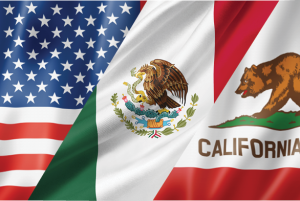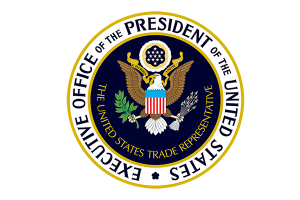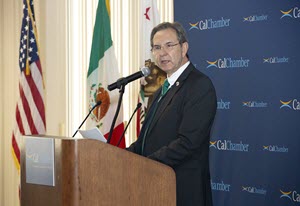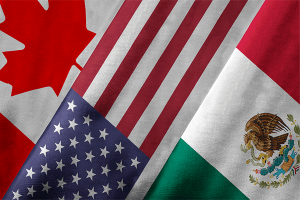U.S.-Mexico-Canada Agreement (USMCA)

USMCA Full Text of the Agreement United States-Mexico-Canada Agreement Website Key Milestones |
| USMCA Forward 2025 -Research Brookings, March 5, 2025 |
Background
President Donald J. Trump announced his intent to renegotiate the NAFTA in May 2017. The negotiations started shortly thereafter, going through many rounds. In August 2018, the United States and Mexico reached a preliminary agreement, while the U.S. continued separate negotiations with Canada. In October, Canada and the United States came to an agreement right before a self-imposed deadline, reassuring the deal would remain trilateral. The pact was rebranded the United States-Mexico-Canada Agreement (USMCA).
The USMCA is a necessary modernization to NAFTA that recognizes the impacts of technology on the three countries’ economies. There are new chapters on good regulatory practices, digital trade, small and medium-sized enterprises (SMEs), the environment, and labor. In total there are 34 chapters: 10 new chapters and 24 modernized chapters.
The USMCA deal improves access to Canada’s dairy market for U.S. farmers, giving U.S. exporters an estimated additional 3.59% market share. It also provides for stronger intellectual property provisions, and tighter rules of origin for auto production, according to the Trump administration.
On June 23, 2020, Dr. Luz Maria de la Mora, Undersecretary for Foreign Trade at the Mexican Ministry of Economy, said “the USMCA brings certainty, clear rules, maintains free trade and preserves North American integration.”
U.S.-Mexico-Canada Trade Agreement: Likely Impact on the U.S. Economy and on Specific Industry Sectors
International Trade Commission Report, April 2019
Benefits and Goals
CalChamber support for the USMCA is based on an assessment that it serves the employment, trading and environmental interests of California, the United States, Mexican and Canada, and is beneficial to the business community and society as a whole.
The objectives of the USMCA are to eliminate barriers to trade, promote conditions of fair competition, increase investment opportunities, provide adequate protection of intellectual property rights, establish effective procedures for implementing and applying the agreements and resolving disputes, and to further trilateral, regional and multilateral cooperation.
CalChamber Support
The CalChamber actively supported the creation of the USMCA, the successor to the North American Free Trade Agreement (NAFTA).
The United States, Canada and Mexico comprise more than 490 million people (6.5% of the world’s population), a $26 trillion gross domestic product (GDP) (18.3% of world GDP), and $6 trillion in trade (nearly 16% of global trade).
Due to California’s position as a global leader in international trade, the priorities of the USMCA are important to the CalChamber’s members and the overall economic health of the state.
Major Provisions
6-Year Review
Halfway to the six-year review: One novel feature of the USMCA is that it expires after 16 years, unless Canada, Mexico and the United States agree to extend it for 16 more.
But that process actually begins in Year Six of the pact, or 2026, when each country can either confirm its desire to extend the agreement or raise concerns that it wants addressed. In the latter scenario, the three countries will continue the review every year until either the concerns are resolved or the pact is terminated in Year 16.
COVID-19
“The crisis and recovery from the COVID-19 pandemic demonstrates that now, more than ever, the United States should strive to increase manufacturing capacity and investment in North America. The USMCA’s entry into force is a landmark achievement in that effort,” U.S. Trade Representative Robert Lighthizer said in April 2020.
Mexico’s Economy Ministry said the USMCA’s implementation will “drive [economic] recovery of our country, of the North American region, after the health crisis caused by COVID-19.”
Certificate of Origin
One of the major changes as a result of this trade agreement is elimination of the NAFTA Certificate of Origin. Instead, the USMCA will replace the Certificate of Origin with a certification. This will now be similar to other free trade agreements, such as the Korean and Australian, which also use a certification. The certification will not be required for noncommercial shipments and imports valued at less than $2,500.
Customs De Minimis
The de minimis threshold sets the value of goods below which no duties or taxes are collected by customs. According to the U.S. Department of Commerce, to help make trade easier, faster, and cheaper, the following de minimis levels shipment values will be followed. Shipments up to these de minimis values will generally enter with minimal formal entry procedures.
• Canada will raise its de minimis level for North American express shipments from C$20 to C$40 for taxes. It will also provide for duty-free treatment for express shipments up to C$150.
• Mexico will continue to provide US$50 tax-free de minimis and also provide duty-free treatment for express shipments up to the equivalent level of US$117.
• The United States will maintain its de minimis level at US$800.
Auto Regulations
The three North American trading partners have wrapped up talks on uniform regulations to implement the USMCA’s rule of origin, including on autos and clears one of the most challenging issues for USMCA implementation. Officials in the United States, Mexico and Canada have been working since March to craft the regulations, which include specific formulas and information on how automakers must comply with the new rules to qualify for reduced tariffs under USMCA.
Automakers indicate that complying with the rules will require time-consuming and costly changes, made more difficult by the economic fallout from the pandemic—but the regulations offers auto companies a transition period between July 1 and the end of the year.
Labor Issues
Appointments are being made to the newly created independent Mexico labor expert board, which will monitor and evaluate whether Mexico is implementing its promised labor reforms in a timely manner.
Mexico Statistics
In the last 20 years, two-way trade in goods between Mexico and the United States increased dramatically from $81.4 billion in 1993 to $779.3 billion in 2022, up from $661.16 billion in 2021. Today, Mexico stands as the United States’ second largest trading partner. Since 1995, Mexico has been a top trading partner for the U.S.
United States’ exports to Mexico totaled $324.37 billion in 2021. Mexico is the first or second largest trading partner for more than half of U.S. states. Top export categories from the U.S. to Mexico included computer and electronic products, petroleum and coal products, chemicals, transportation equipment, and non-electrical machinery. $1.47 billion a day in two-way trade of goods and services crosses the border. There are over 50,000 small and medium sized enterprises in the U.S. that export to Mexico.
Mexico continues to be California’s No. 1 export market, purchasing 16.5 percent of all California exports. California exports to Mexico amounted to $30.77 billion in 2022. Computers and electronic products remained California’s largest exports, accounting for $5 billion of all California exports to Mexico. Exports of transportation equipment, chemicals, non-electrical machinery, and processed foods from California to Mexico made up $3.5 billion, $2.3 billion, $2.3 billion, and $2.1 billion respectively. California was the second largest exporting state to Mexico in 2022.
Also in 2022, California imported $60.47 billion in goods from Mexico. The top import categories were computer and electronic products, transportation equipment, agricultural products, electrical equipment, and miscellaneous manufactured goods. California was the second largest importing state for goods from Mexico in 2022.
Mexico FDI Statistics
U.S. foreign direct investment (FDI) into Mexico totaled $110.68 billion in 2021 and Mexican FDI into the US totaled $48.13 billion in the same year. In 2020, Mexican FDI into the U.S. supported 88,900 jobs and contributed a value of $1.4 billion to expanding US exports. The top industry sectors for Mexican FDI in the U.S. were: food and beverages, auto components, plastics, business services, communications, and software & IT services. Select USA
Mexico climbed four spots to become the No. 12 destination in the world for FDI in 2017, according to the United Nations Conference on Trade and Development. Foreign investment to Mexico reached $29.7 billion, despite uncertainty about the renegotiation of NAFTA. Investment in the automotive industry grew 32% to $7 billion. (June 2018 Milenio)
In California, the tenth largest source of FDI through foreign-owned enterprises (FOEs) is Mexico. In 2022, Mexican FOEs in California provided 16,555 jobs through 544 firms amounting to $1.69 billion in wages. The top jobs by sector are: wholesale trade, manufacturing, retail trade, professional/business services, and financial activities (World Trade Center Los Angeles FDI Report).
Canada Statistics
The United States and Canada enjoy the largest bilateral trade and investment relationship in the world. In 2022, two way trade in goods between Canada and the United States topped $792.77 billion, an increase over the previous year of $665.5 billion in 2021. Exports to Canada were $354.9 billion in 2022, making it the largest export destination for the U.S.
Canada has remained California’s second largest export market since 2006, with a total value of over $20.1 billion in 2022 (12 percent of all California exports). California imports $23.7 billion from Canada.
Computers and electronic products remained California’s largest exports, accounting for $5.06 billion.
Canada FDI Statistics
According to the most recent figures, U.S. companies invested approximately $406.35 billion into Canada and foreign direct investment from Canada into the U.S. was nearly $607.25 billion in 2021 (Bureau of Economic Analysis). This makes Canada the third largest source of FDI in the U.S. FDI from Canada directly supported 844,600 jobs in the U.S. in 2020. Canada invested $1.5 billion in research and development and contributed a value of $13.4 billion towards expanding U.S. exports. The top US industry sectors that Canada FDI goes to are: software and IT services, business services, financial services, real estate, industrial equipment, and food and beverages (SelectUSA).
In 2022 in California, Canada returned to its spot as the fourth largest source of FDI through foreign-owned enterprises (FOEs). In 2022, Canadian FOEs provided over 62,441 jobs through 1,604 firms amounting to $6.7 billion in wages. The top jobs by sector are: professional/business services, manufacturing, financial activities, information, and wholesale trade (World Trade Center Los Angeles FDI Report).

USCMA is a Truly Bipartisan Effort One-Year Later: What They’re Saying About USMCA Landmark U.S.-Mexico Canada-Agreement Brings Modernized Rules to Trade on July 1 Canada OK of U.S.-Mexico-Canada Pact Could Lead to June Implementation Date Mexico Chief Negotiator Provides Insight on USMCA at CalChamber Lunch President Trump Signs USMCA Trade Pact USMCA Passes Senate, Awaits President Trump’s Signature CalChamber Welcomes House of Representatives Vote to Approve USMCA CalChamber Welcomes News of Progress on USMCA Statement from United States Trade Representative Robert Lighthizer (on USMCA) Brady, Buchanan Statements on USMCA Agreement U.S. Chamber Statement on USMCA Handshake Deal CalChamber Once Again Urges Congressional Support for USMCA CalChamber Reiterates Support for U.S.-Mexico-Canada Agreement U.S., Mexico, Canada Sign New Trade Agreement The New USMCA trade pact replaces NAFTA to Create ‘Freer’ and Fairer’ Economic Growth in Our Region – Trade with Mexico and Canada Supports nearly 14 million American jobs. – Since NAFTA entered into force, trade with Canada and Mexico has nearly quadrupled to $1.3 trillion. – NAFTA helped U.S. agriculture exports to Canada and Mexico to increase by 350% – Canada and Mexico buy more than 1/3 of U.S. merchandise exports |
Related News
Resources
U.S. Trade Representative – USMCA
U.S. Dept. of Commerce International Trade Administration – USMCA
USMCA Presentation to California Office of Business and Development
August 11, 2020
Fact Sheets
Modernizing NAFTA to Be a 21st Century Trade Agreement
Strengthening North American Trade in Agriculture
Agriculture: Market Access and Dairy Outcomes of the USMC Agreement









